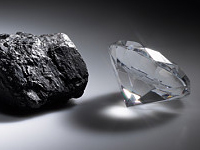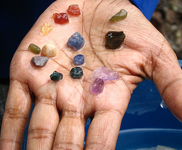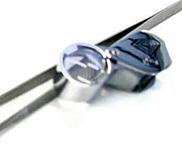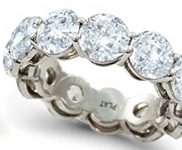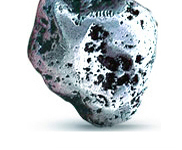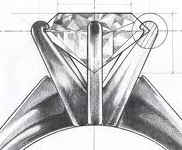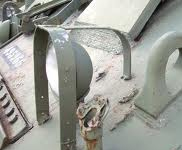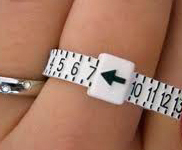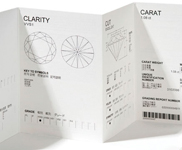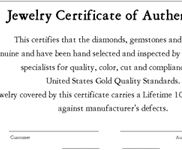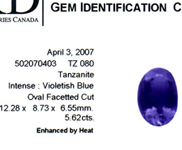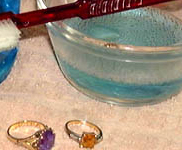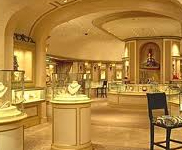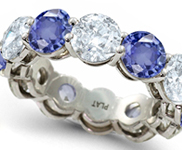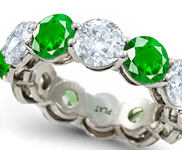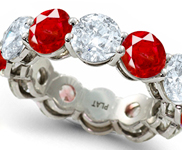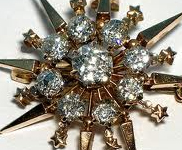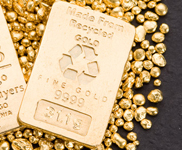
![]() 800.871.1066 |
800.871.1066 | ![]() E-Mail |
E-Mail | ![]() Sparkle N Dazzle Co. 54 W 47th St Suite #4R, New York, NY 10036
Sparkle N Dazzle Co. 54 W 47th St Suite #4R, New York, NY 10036
Sndgems jewelry guides are easy to use, interesting and helpful guide to buying jewelry online. Our jewelry guides are indispensable guide to judging jewelry characterstics, distinguishing genuine from imitation, making wise choices, useful to all type of consumers, from professional jewelry to online searchers. Our diamond guides help everyone in viewing diamonds as gemologists, diamond experts, diamond dealers, experienced lapidaries, diamond buyers and online customers. Our diamond guides dissects each aspect of diamond value in detail with a wealth of diamond grading information. Our gemstone guides help everyone in viewing colored gemstones as gemologists, gem dealers, experienced lapidaries, gem buyers and online customers. Our gemstone guides dissects each aspect of ruby, sapphire, ruby value in detail with a wealth of gemstone grading information. Our guides offers step-by-step instructions for how to examine and judge the quality and craftsmanship and materials even if you dont know anything about jewelry. If you're thinking of buying jewelry online this guide is a best place to start. Our guides will help you to know about jewelry details such as finishes, settings, flaws and fakes. Our guides cover diamonds, gemstones, jewelry craftsmanship, treatments, diamond and gems sources, appraisals. There is something for everyone.
The Art of Gemstone Lapidiary
The process of cutting and polishing gemstones is called gem cutting or lapidary. Gemstone material that has not been cut and polished is referred to generally as gemstone rough example diamond rough, sapphire rough , ruby rough or emerald rough. All gems are cut by progressive abrasion using finer and finer grits of harder substances. Diamond bits being the hardest material found on earth are widely used to cut and polish a wide variety of gemstone types along with compounds like Silicon carbide that rate very high on hardness on a moh's scale.
At first the rough material is lightly hammered to knock off brittle, fractured material. This is called cobbling next the rough stone undergoes a series of techniques like Sawing, grinding, sanding, lapping, polishing, drilling, and tumbling before we get to see the beautifully cut gemstone that is used for designing exquisite pieces of jewelry like diamond engagement rings, wedding rings, anniversary rings, sapphire rings, emerald rings and ruby rings. Some designer jewelers making gemstone art use a combination of faceting and hand carving to create unique gemstone shapes.
Gemstone Slicing and sawing: During this process an experienced gem slicer carefully determines how to cut the gemstone, where to cut it, and how many pieces he should to cut into in order to produce the highest quality gemstone. If the rough is cut incorrectly its beauty and value may be diminished drastically.
Gemstone Grinding and Pre-forming : During this process an expert gem cutter determines both the shape and orientation for each gemstone using a vertical steel grinding wheel or a silicon carbide wheels or diamond-impregnated wheels.
Gemstone Shaping: During this process an expert gem cutter tries to give a more accurate cut to the facets and size using a special type of heat activated resin to affix the pre-formed gemstone onto a metal rod, called a dop stick. Shaping is completed using a hand-operated shaping wheel.
Gemstone Polishing: Once gemstones have reached their ideal size and shape, they are taken to a steel (or steel and copper) horizontal polishing wheel where the polisher completes the faceting and gives them a final polish using fine diamond paste to reveal their hidden luster, brilliance and fire.
Difference between gemstone shape and cut: A shape is the face-up outline form of the gemstone, be it round, oval, square, rectangular, pear, marquise or trillion. Given a gemstone of a certain shape, a gem cutter or lapidary can decide to cut that gem with different styles of facets, or no facets at all. An example of a no facet gemstone is a cabochon with a domed top also called a plain cut. A faceted cut has a number of separate small planes. There are also mixed cuts which combines the two; for example, a gem with a faceted pavilion and a plain crown. The Facet cuts are differentiated based on the shape of a facet. There are many kinds of facet shapes the most popular being the brilliant cut, the step cut and the mixed cut. Brilliant cuts generally have rhomboid and triangular facets in a radial pattern while step cuts have trapezoid or rectangular facets in concentric rows; and mixed cuts combine both brilliant and step-type facets. A detailed description of the various facet cuts can get quite complicated and technical. To sum up there are unlimited ways a gemstone may be cut or faceted given a gemstone shape. Gemstone facets help to maximize color & brilliance. Gemstone cutting refers to both the facet cuts as well as the shape. There are standard cuts that we all recognize, like round brilliants and emerald cuts. Most faceted gems are simply called by their shape. However, you need to recognize that there are many variations within each shape.
Developments in gemstone cutting technologies and equipments in the 1800 led to innovations in gemstone cutting models. For example In 1919, Marcel Tolkowsky joined together the art of cutting with the science of refraction and light and published his book, The Diamond Design. Now a day’s diamond and gemstone cutting work is based on more accurate mathematical models engineered to enhance the color, brilliance and maximize the weight of gemstone rings. In the 1980's a computer program was designed called the Gem Cad. It allowed people to test their cutting designs inside a computer before taking a stone to a lapidary. This made it easy for people to create new gem cuts and today endless number of gemstone cutting styles as well as computer software’s for designing new cuts.
Some important factors that we need to keep in mind when engaging in the art of gemstone lapidary are:
1. Unlike diamonds, colored gemstones possess variable optical properties and are not cut to a uniform ideal. A well-cut colored gem exhibits even color, an acceptable number of inclusions, good brilliance and shows the majority of carat weight when viewed from the top.
2. The original shape of the gem rough i.e., the shape of the raw gemstone crystal as it comes from the earth.
3. The oval shape is most frequently used, as it best balances beauty, color and carat weight retention.
4. Other factors that we need to consider when choosing to facet a gemstone in another shape include design aesthetics, inclusions, carat weight loss and color.
Art of Gemstone Cutting - Types of Gemstone Cuts
There is no fixed or standardized rule that can be applied to various gemstone cuts. However the most common types of cuts can be grouped into three categories namely faceted cuts, plain cut and mixed cuts.
Plain Cut or Cabochon Cut: This cut is suitable for agates and other opaque stones. A cabochon is a stone that has a rounded or convex top with no faceting and a flat or slightly domed base and is highly polished. A cabochon may be cut in any shape, but ovals are the most preferred. The following types of gemstones are generally cut as cabochons. Gemstones that are opaque are cut as cabochons rather than faceted. Gems that display asterism (the star effect) or chatoyancy (the cat's eye effect) or iridescence (for example opal) or adularescence (for example moonstone) are cut as cabochons to retain their unique characteristics. Lower grade material in gemstones such as sapphire, ruby and garnet are also cut as cabochons. Softer gemstones with a hardness less than 7 on moh'scale are also cut as cabochons to prevent scratches. Certain stones are almost always cut as cabochons like turquoise, onyx, moonstones, and star sapphires.
Faceted Cuts: All transparent gemstones are faceted to help to maximize color and luster. Most facet cuts are built on the Brilliant Cut and the Trap or Emerald Cut. Faceting is the cutting and polishing of flat planar surfaces in a geometric pattern on a transparent gem material. The facets are cut utilizing diamond-charged, flat disks that rotate horizontally on a platter much like a record on a turntable. Most facet cuts are built on the brilliant cut and the trap or emerald cut. It was during the late 13th and early 14th centuries that faceted gemstones made their appearance in European jewelry .Controlling and enhancing the light coming from within the stone and designing geometric faceting schemes became possible in the late 1400 with the invention of the horizontally turning cutting-wheel. The fascination with geometry and reflected light during the Renaissance accelerated the development of a sophisticated lapidary art and the management of light became the central theme in gem cutting.
Brilliant Cut: The brilliant cut creates the best balance of brilliance, dispersion and scintillation and hence is ideal for diamonds. But in the case of colored gemstones lapidaries pay greatest attention to color maximization instead of brilliance or dispersion and hence this cut is not very popular in colored gemstones. Brilliant cutting style can be carried out on various shapes like pear, marquise, heart & cushion shape.
Step or Emerald cut or Trap cut: Next to brilliant cut this is the most popular cutting style. It is generally used on rectangular, square or angular gemstones with truncated corners to prevent chipping or fracture. Emerald cuts help to maximize color the best and most, and hence it is a very popular cut in colored gemstones. However in this cut inclusions become more noticeable and therefore this cut works best with gemstones that have a good rich color.
Mixed Cuts: In Mixed Cuts the gemstone has brilliant cut crown with a step cut pavilion. This style is often used in cutting rubies and sapphires and other colored gemstones as this cut helps to maximize weight. Mixed cuts need to be cut very carefully as it may easily result in the loss of light and brilliance if the facet rows nearest the girdle are cut too steep.
It is to be noted that brilliant cut style and the step cut or emerald cut have been worked on by many expert jewelers and new variations to these cutting styles has evolved over the years.
Modifications of the brilliant cut style include the following: Old European cut, Brazilian cut, English square-cut brilliant, old-mine cut, Libson cut, double-cut brilliant, semi-navette, scissors cut, spiral cut, Portuguese cut, brilliant-cut briolette, zircon cut, honeycomb cut, Cairo star cut, star cut, marquise cut, pear-shape cut, heart-shape cut, single cut, French cut, all rose cuts, rondelle, Swiss cut, split brilliant cut, twentieth century cut, King Cut, oval cut, English round-cut brilliant, jubilee cut, Magna Cut, half-moon cut.
Modifications of the step cut or emerald cut include the following: Trap brilliant, square emerald cut, baguette, tapered baguette, square cut, table cut, bevel cut, step-cut bead, triangle cut, bullet cut, keystone cut, hexagon cut, long hexagon cut, kite cut, lozenge cut, trapeze cut, pentagon cut, epaulette cut, tapered pentagon cut, cut-corner triangle, octagon cut, whistle cut, rhomboid cut, fan-shape cut, shield cut, window cut.
Barion Cut: The barion cut was developed by South African diamond cutter, Basil Water Meier. A Barion is a type of design that has moon shaped facets (at the girdle) with the central part of the design being a brilliant (all the mains meet at the same point and the break facets meet a different point) and there is (usually) a set of fan facets which connect to the half moon facets. Barion cut produces much more brilliance than a standard round brilliant cut as well as helps in greater weight retention as barions do not allow rounding of the pavilion. Barion cuts can be applied to all fancy and angular gemstones like trapezoids, kites, emeralds, squares, pentagons, hexagons and triangles.
Rose Cut: Some gems cutters combine faceting and cobbing. A gem with a faceted top and a flat bottom is called a rose cut. Rose cut diamonds were introduced as early as the 1500's and were popular until the early 1900's.
Ceylon Cut: Ceylon cut has a step cut pavilion and a brilliant cut crown. This is an ancient technique and one still used in Sri Lanka today. Modern computer studies have shown that the reverse, a step cut crown over a brilliant cut pavilion, will often produce the greatest brilliance.
Princess Cuts: The face-up shape of the princess cut is square or rectangular and the profile or side-on shape is similar to that of an inverted pyramid with four beveled sides. The square princess cut diamond is usually slightly cheaper than round brilliant cut diamonds of the same carat weight because it retains about 80% of the rough diamond, as opposed to the round brilliant which retains only about 50% of the rough. The ability to retain more crystal weight makes this shape popular amongst diamond and gemstone cutters.
Trilliant Cut: Trilliant Cut gemstones are fancy triangular cuts. The sides are even (width and height the same) and they usually have about 50 Facets on them, versus the Round's 58 Facets. Trilliant cuts are ideal for light-colored gems like diamonds, aquamarines, beryls and white sapphires where the aim of the cutter is to maximise brilliance or when the cutter tries to lighten and brighten the appearance of darker stones like tanzanites, garnets and amethysts. Trilliants are rarely used for softer gems, unless the corners are rounded. Trilliant cut gemstones are generally bezel set by jewelers. Some however prong set them.
Shield Cut: In a Shield Cut the gemstone is cut giving it a somewhat triangular shape with the top side bowed and the two other "sides" composed of two bowed edges. The overall shape resembles the shields used by warriors throughout history. Shield cut gemstones are used as side stones for rings where their wide end is fitted next to the center stone and the pointed end runs down the shank of the ring.
Mirror Cut: It is a variety of the Table cut. Some famous historic stones like the “Mirror of Portugal” and the “Mirror of France” have been cut into this shape. The mirror cut is characterized by an extraordinarily large table and thick girdle consisting of as much as 90% of the width of the gem. This makes the gem highly refractive and literally gives it the properties of a mirror and hence it called the mirror cut. This cut helps to retain the weight of the gemstone.
Briolette Cut: The Briolette Cut is a drop-shaped stone with triangular or diamond-shaped facets all the way around. There is no table, crown or pavilion. The more facets, the more brilliant the stone appears. The facets on a Briolette are all triangular in shape entirely covering the circular cross section of the stone. A lot of Briolette Cutting is done in India . During the Victorian and Art Deco periods the Briolettes cuts became very popular but faded with the depression and post war years of the 20th century. Briolette cuts are popular with designer-manufacturers & retailers and in the auction market. In the antique or estate jewelry, they are also included in tiaras. Rounded or pear-shaped Briolette cuts have lot of brilliancy. If the shape is not rounded it tends to lose its brilliancy. Briolette cuts look gorgeous in earrings.
Buff Top Cut: A buff top is a cabochon variant for transparent gems. Buff top gemstones are cut with cabochon crown i.e the crown is dome shaped with no facets while it has a faceted pavilion for better brilliancy. This cut shows good brilliance and has a crown that is less easily abraded than those of faceted gems.
Concave Cut: Concave facets are uniquely three-dimensional wherein each facet has length, breadth and depth. In a concave cut gemstone a three dimensional conical shaped facet is applied to the pavilion of the gem that creates depth as well as length and breadth. Facets are joined with a groove instead of being joined by an angle. This third dimension allows the gem to refract more light, thereby maximizing its brilliance. The concave cut also distributes light more evenly leading to an even interior glow. However, only certain types of gemstones benefit from concave cutting style. Larger gems exhibit greater brilliance with this technique than smaller ones. Also light or medium-colored gemstones benefit from this cut in terms of maximizing brilliance than gems with highly saturated color. According to gem experts darker stones with high color saturation like rubies may look even darker and less attractive when cut with concave facets.
Portuguese Cut: The Portuguese cut is one of the most popular fancy cuts. A number of gemstones are cut using this style. This cut has an extra row of facets on the crown that help to enhance the brilliance of a gemstone. It has two rows of rhomboidal and three rows of triangular facets above and below the girdle and its table is smaller due to the extra row of facets on the crown.
Zircon Cut: The zircon cut is a variation of the round brilliant cut that adds eight extra facets to the pavilion of the gemstone. This style was invented to take advantage of the properties of a Zircon. An interesting characteristic of zircon is that its birefringence is great enough to producing visible doubling of the back facets in larger stones. Zircon also has a diamond-like luster, lending further credence to its suitability as a diamond substitute.
Swiss Cut: In a Swiss cut the crown is built up out of a table facet, eight crown star facets and eight bezel facets and its pavilion is built up out of eight main and eight bezel facets. This cut is now very popular nowadays and has been replaced by the new single cut. This cutting style was used to cut smaller stones that surrounded the large brilliant cuts.
Scissors Cut: Scissors cut is a variation of the step cut and is ideal for concealing the gemstones internal flaws and adding a bit more brilliance to darker gemstones. In this cut the facets are divided into four sub-facets by the "scissors", some have truncated corners while others are cut with square corners.
French Cut: This cuts adds slightly more brilliance to a dark stone, and is good for concealing internal flaws. The french cut is also used on very small stones where a brilliant cut would not be practical. French cut stones are square or rectangular multifaceted stones. They are derived from making optimal use of a rhombic dodecahedron diamond crystal. To cut the Crown of a French cut diamond one of the tops of the crystal is ground down to create a Table that sits diagonal to the sides of the crystal. At this point the remaining crystal faces form natural facets that only need slight modeling to make it a symmetrical cut French cut is a variant of the step cut and the scissor cut is a slightly more elaborate variety of a French cut.
Old European Cut: Old European cut diamonds continued the characteristic of the old cuts with their open culet and higher crown. It is similar to the old mine cut, but is round rather than squarish and has 58 facets. The old European cut was the direct forefather to the modern round brilliant cut.The old European cut was studied to create measurements for the modern brilliant ideal cut diamond. Rounder in shape than the old Miner cut, and cut with a circular girdle, the Old European cut is similar to but still far from its direct descendant –the round brilliant cut.
What is a Genuine Gemstone? Know All About Genuine Gemstones. Read More.
What is Authentic Jewelry? Know All About Authentic. Read More.
What is Certified Jewelry? Know All About Certified Jewelry. Read More.
What is Fine Designer Jewelry? Know All About Fine Jewelry. Read More.
Genuine Gemstones Identification? Know All About Fine Genuine Gemstones. Read More.
What is Real Gold, Platinum, Silver, Palladium or Fake Gold Filled, Gold Plated? Know All About Real Gold, Platinum, Silver, Palladium, Platinum, Silver, Palladium. Read More.
Jewelry Caring & Cleaning, Ruby Jewelry Caring & Cleaning, Sapphire Jewelry Caring & Cleaning, Emerald Jewelry Caring & Cleaning, Diamond Caring & Cleaning. Read More.
Genuine Diamond Testers, Genuine Gemstones Testers, Real Metal Testers, Authentic Jewelry Testers. ? Know All About Testers to Identify Natural Diamonds, Genuine Gemstones, Real Metals and Authentic Jewelry. Read More.
Identification of Synthetic or Fake Emeralds from Genuine Emeralds Guidelines. Read More.
Identification of Synthetic or Fake Rubies and Sapphires from Genuine Rubies and Sapphires Guides. Read More.
Gemology 101: Gemologists Identification & Valuation of Gemstones Diamonds. Read More.
Identification of Synthetic or Fake Imitation Diamonds from Genuine Diamonds Buying Guides. Read More.
Learn about Diamond Ring Styles and Designs – Choose your Perfect Engagement Ring, Anniversary Ring or Wedding Ring. Learn More.
The Worlds Top Jewelry Stores, Online Shopping Guides. Read More.
How is our fine jewelry made. Read More.
Why our jewelry selection is the largest. Read More.
Why our fine jewelry is offered at the lowest prices. Read More.
Why our jewelry is the best. Read More.
Wy our moneyback guarantee is totally assured. Read More.
![]() Gemstones
Mining
Gemstones
Mining
![]() Famous
Gemstones
Famous
Gemstones
![]() Largest
Gemstones
Largest
Gemstones
![]() Gems
Laboratory
Gems
Laboratory
![]()
©2020 Sndgems, LLC | Terms & Conditions | Privacy Policy
